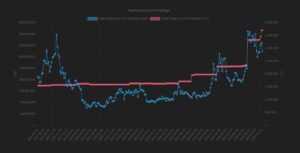Dollar-pegged stablecoin Tether (USDT) reached a new landmark, hitting a cumulative $20 billion market cap across various blockchains over the weekend.
USDT is the most widely used stablecoin in the crypto industry and continues to be the on-off-ramp of choice for fiat-to-bitcoin conversions.
For comparison, Tether’s market capitalisation is technically higher than Iceland’s entire gross domestic product.

Across the spectrum of cryptocurrencies, stablecoins have been doing well, with over $26 billion locked in various dollar-pegged assets, per data from CoinGecko.
At current valuations, Tether dominates the USD stablecoin market, commanding nearly 80% of the entire market. The stablecoin is issued across multiple blockchains such as Tron and OMG but is predominantly based on Ethereum. Just today, Tether CEO Paolo Ardoino also hinted that USDT might also be issued on the bitcoin lightning network in the weeks ahead.
Traders find USDT particularly useful for moving money around freely without having to go through the lengthy and cumbersome processes that come with traditional finance. Since its official launch in 2015, the circulating supply of USDT grew to $2 billion in 2017—representing a massive 1,000% since then.
To get a sense of Tether’s speed of growth, back in April of this year, the USDT market cap was just $4 billion. It’s now pushing $20 billion.
Buying bitcoin? Start here.
Is stablecoin regulatory FUD warranted?
However, being the biggest kid on the block doesn’t come without consequences. Indeed, every so often, the stablecoin undergoes a period of ‘FUD’ (fear, uncertainty & doubt) which in large part is speculation on the ongoing legal battles in the Tether Saga. As reported by cryptonews.com, stablecoins such as Tether could face an uncertain future as governments step up regulations on cryptocurrencies, particularly stablecoins.
But in light of the fact that USDC has obtained complete regulatory oversight in their mission to issue a 1:1 USD-backed stablecoin, a total collapse of the largest player doesn’t seem likely (bearing in mind that both USDT and USDC operate in the same space). USD Coin is run by Circle, which is in turn owned by Coinbase and is the second largest stablecoin by market capitalisation – currently at $3.2 billion according to data from Coingecko.
The threat that could be more ominous is the eventual roll-out of Central Bank Digital Currencies. Indeed, in a digitised world where fiat currency runs on a blockchain, would government-backed central banks be welcoming of private stablecoins when they’ll have issued their own?
The answer to that question seems more straight forward than USD Tether FUD.
Subscribe to the semi-weekly newsletter for regular insight into bitcoin and crypto. Go on. It’s free.
Join the telegram channel for updates, charts, ideas and deals.
Did you like the article? Share it!


